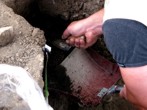|
|
| Dating |
 A number of methods and techniques have been developed to determine the age of archaeological sites and their remains. These can be divided into two basic categories: relative and absolute dating. The basic difference between them lies in the fact that the former correlates the archaeological remains one to the other and orders them sequentially, whereas the latter can determine their precise age. Their simultaneous use in archaeology is very useful, since the former uncovers the sequence of the events while the latter the actual time in which they occurred. A number of methods and techniques have been developed to determine the age of archaeological sites and their remains. These can be divided into two basic categories: relative and absolute dating. The basic difference between them lies in the fact that the former correlates the archaeological remains one to the other and orders them sequentially, whereas the latter can determine their precise age. Their simultaneous use in archaeology is very useful, since the former uncovers the sequence of the events while the latter the actual time in which they occurred. |
| |
| Relative dating |
Relative dating is mainly based on stratigraphy, typology and chronological interrelation.
- The stratigraphy of an archaeological site is the distinction of various layers within the archaeological section. Stratigraphic dating is based on "the law of superposition" of layers, which means that more recent layers will cover the older ones. However, this is not always the case, since natural factors (e.g. the erosion of layers and the existence of animal burrows) and human intervention (e.g. the opening of pits) may affect the natural sequence of the layers, thus making it difficult to understand the order in which they were deposited.
- Typology is the study of artefacts and their ordering into groups on the basis of their morphological and technical characteristics. When artefacts with characteristics that belong to a dated typological group are found in some archaeological level, this level can be dated immediately. During the surface survey at Paliambela, similarities between the collected pottery and analogous examples from excavated settlements in Thessaly and Macedonia gave an initial idea of the chronology of the site in the various phases of the Neolithic.
- Chronological interrelation attempts to recognise the interrelations in the stratigraphy of areas of the same location or even in different locations and to compare artefacts with a known relative or absolute chronology, in order to be able to draw conclusions in relation to the axis of time. At Paliambela the stratigraphic interrelation between the trenches is aided by the use of GIS and the diagrammatical representation of the stratigraphy (or Harris Matrix).
|
|
| Absolute dating |
There are many, mainly laboratory, methods that can determine the age of an artefact. As such, the most reliable method is that of carbon 14 (C14) and its combination with the dendrochronology method.
- The element C14 is an isotope of C12 which is found in all living things in stable amounts. After the death of an organism the C14 ratio begins to decrease. Its rate of decay is half the original amount every 5,730 years. The technique measures the C14 ratio in any organic material (skeletons, the remains of wood) and so can determine its age. The precision of the technique depends on the amount of the sample, its age (the method can cover material aged up to 50,000 years) and the non-contamination of the sample during its collection. However, in no case can it be considered to be absolutely precise; there is always a margin of error.
- Dendrochronology is a method based on the rule that trees add a new ring of growth every year. The width of the rings is affected by seasonal and yearly climatic conditions in such a characteristic way, that it is possible to link sequences of rings from different trees into a unified sequence based on their common characteristics.
 In this way, sequences have been formulated that begin from the present day and reach back thousands of years. In such a sequence each ring represents one year. The sequence can be used either to date new pieces of wood, or to correct the ages that emerge from the use of C14. Alternatively each ring is dated using the C14 method and the result (radiometric age) is compared with the position of the ring in the unified sequence. Since each ring represents one year, this comparison gives us "calendar" dates. This type of systematic measurement has produced the so-called "correction curves", that is charts for converting radiometric dates to calendar dates. In this way, sequences have been formulated that begin from the present day and reach back thousands of years. In such a sequence each ring represents one year. The sequence can be used either to date new pieces of wood, or to correct the ages that emerge from the use of C14. Alternatively each ring is dated using the C14 method and the result (radiometric age) is compared with the position of the ring in the unified sequence. Since each ring represents one year, this comparison gives us "calendar" dates. This type of systematic measurement has produced the so-called "correction curves", that is charts for converting radiometric dates to calendar dates.
|
|
|





